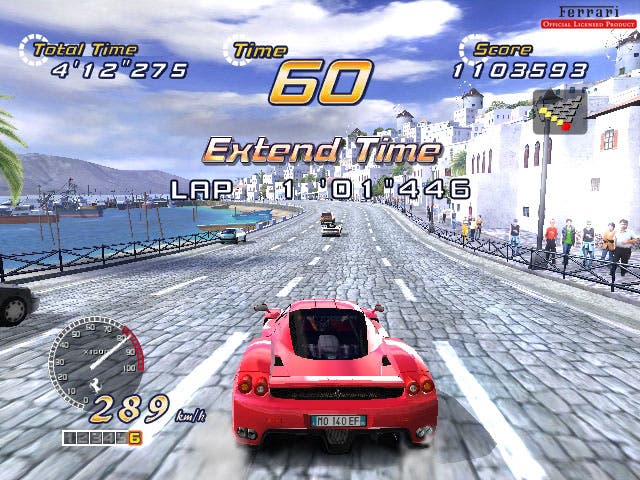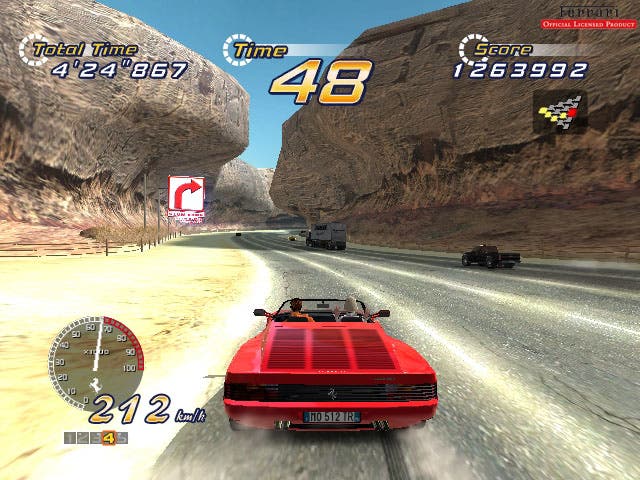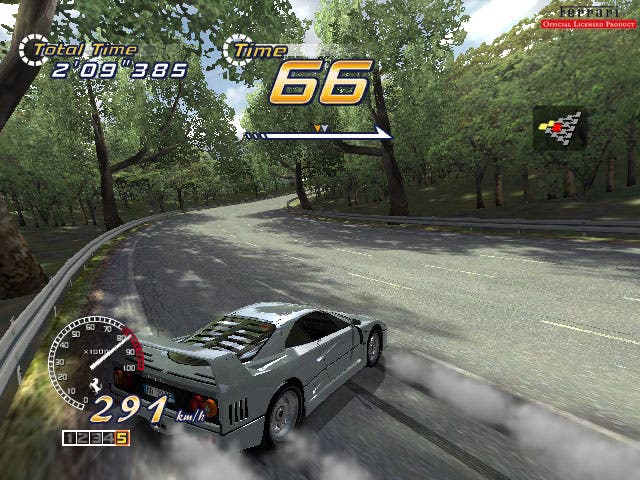OutRun2
It's undoubtedly a beautiful journey, but you might be surprised how quickly you get there.
Order yours now from Simply Games.
As much as we'd like to take it in isolation and extol its virtues unshaken by the knowledge of meatier challenges a couple of shelves away, it's impossible to talk about OutRun2 - one of the most single-minded racing games we've played - without contrasting it with the depth and scope of Burnout 3, released just three weeks earlier. And it's a comparison that hurts the SEGA title. Burnout 3, simply, was built from the ground up to be satisfyingly vast, and it succeeded. You won't run out of things to do for weeks. OutRun2, meanwhile, is completely the opposite - a concise racing challenge geared towards delivering short-term thrills in the arcade, with reversed tracks and a couple of unlockable bonuses, task-oriented mission modes and Xbox Live support drafted in over the last year to try and boost its appeal to console owners.
But, while Burnout 3's depth exposes the shallow thrills of OutRun2 for what they truly are, there's nothing in Burnout's arsenal that can detract from the delightful precision of the SEGA title. While Burnout's profligacy sometimes drives it off the road - most notably in the online stakes - OutRun2 shoulders the burden of being a one-trick pony and says, "Fair enough, but my pony's a silver stallion in the middle of a Ferrari logo screeching sideways round an impossible bend at more than 150mph." It's a convincing argument.
Sightseeing

At the heart of OutRun2 is the game's untouched arcade mode (and it's worth pointing out that, in an increasingly rare scenario, this does actually mean it came from the arcade), which has you screaming through a series of five courses in the Ferrari of your choice, veering left or right at the end of each section to pick an easier or a harder path, in an effort to satisfy the giddy blonde bombshell in the passenger seat.
Pleasingly, the developer uses the various sections to really showcase the Xbox hardware: taking us on a ride across a suspension bridge over a glassy lake; over cloud-smothered hilltops and into the hazy, sun-soaked valleys on the other side; down tree and windmill-lined country roads; along a cobbled seafront past rows of yachts and around menacingly sharp sloping coastal roads; and powersliding through the Paris night, past the Eiffel Tower and rows of street cafés and Christmas tree lights puncturing the darkness with an orange headlight glow. All of which is reflected in the glossy chassis of whichever Ferrari you're driving, at the sort of velocity that a lot of 'arcade' racing games have long since forgotten about.
And yet it's that prancing pony that makes the arcade game such a success. Throw the car into a corner, ease off the accelerator and onto the brake and then clamp the accelerator again and your car will slide almost sideways as it screeches round the bend with relatively little loss of speed. It's almost enough to keep the pace up whatever the angle of the turn, and after half an hour getting used to the feel of the powersliding it's also simple and satisfying to manipulate it to your own ends. A shallow slide, for example, might be a good way to pass the AI-controlled traffic sprinkled up and down the road, but by the same token decent analogue and trigger control can have the backside of your Enzo hugging the apex of the turn even when it ought to be scraping the crash barrier and skimming mph off your speedo.
Man On The Run

But one of the reasons OutRun2 has taken a while to make the transition from arcade to Xbox is the sense that, while perfectly suited to the arcade, the five-minute frenzy of the arcade game simply isn't enough to justify the sort of money people spend on videogames these days. And whoever pointed that out in the upper ranks of the SEGA hierarchy was quite right - even with the arcade's Time Attack and Heart Attack modes thrown in (the latter asking you to perform certain tasks while racing, like driving through red zones on the track, or hitting a line of blue cones), there still wouldn't be enough to see Xbox owners beyond an admittedly deserved rental.
Which is where UK developer Sumo Digital came in. Apart from porting the game to Xbox with full backing - and source code - from original developer AM2, the other part of Sumo's remit was the transform the shallow, five-minute thrills of the otherwise faultless arcade game into a package that could tempt £40 out of wallets. And the results are impressive - a 101-stage mission mode, reversed tracks, bonus tracks that adapt familiar stretches of Scud Racer and Daytona USA into OutRun-style staged affairs, party missions for several players, and extensive Xbox Live support. Not just eight-player racing, which is, the occasional latency-related glitch notwithstanding, easily on a par with Gotham 2 for performance, but also the time trialling and high score implementation. And although it's sadly not integrated with the single-player game to any meaningful degree, the option to upload ghost cars more or less instantly, and compare scores and download ghosts for individual stages, could refresh the charms of the shave-a-second Time Attack discipline.
101 Reasons

Besides the original arcade mode and Live races, mission mode is undoubtedly the biggest timesink, and although it'll sound like a novelty in print, it's far more of a success than we perhaps anticipated, and calls to mind the hair-wrenching Crazy Taxi challenge mode and, in terms of the stop-start cycle and the creeping need to "just finish this series of tasks," some indelible memories of screaming in love/hate at the Project Gotham series. Initially though it seems like a fairly obvious expansion of the Heart Attack mode. You jump through hoops, as instructed, and bank a certain amount of hearts on your heart meter in the process, which you can lose just as easily by straying from the track, pranging other road users or failing your task to a notable level of ignominy. Keep the hearts though and it ups your grade from the starting rank, E, until you hit the minimum pass grade, A, or go beyond that to AA or AAA.
Challenges consist of, yes, driving through different coloured strips on the road, whilst sometimes avoiding neighbouring colours; keeping up a certain pace through shaded sections of track; drifting as much as humanly possible; passing as many cars as possible; and so on. But it isn't long before you encounter the more obscure and enterprising challenges, which ask you to break laser wires between cars, each of which has a certain heart value, or hit Y to snap a photo of a heart as you slide past it on a turn - the quality and clarity of the photo determining how many hearts you bank.
Perhaps the most intriguing though are the maths and memory test tasks. The former has you adding and subtracting numbers suspended above the track as you race, and asks you to drive through the gate with the right answer above it when you get to the end, while the latter hangs various fruit icons over the track and tasks you with driving through a sequence of cone gates topped with the corresponding fruit. Which is hard enough as a passenger, let alone as you're trying to straighten up out of a hairpin. It's interesting enough here to realise how badly a discipline like OutRun impacts your capacity to think straight, but the maths and memory tests are also commendably inventive and satisfying to overcome - although it is a shame that the maths eventually boils down to a fifty-fifty choice between two paths, giving half the forgetful racers a chance to guess their way to victory.
Degrading

But while mission mode will add more than a handful of hours of challenging, task-driven racing to an otherwise short-lived racer, it's not without its flaws. Occasional and frustrating difficulty spikes eventually give way to widespread unfairness, as the final stretches of the branching mission mode map start to toss you around like a rank amateur, and the need for an A grade minimum starts to grate.
However long you've played the game when you reach this point, there's every chance you'll hurl the pad around, thump the cushions and quite possibly give up in despair as you're harpooned on the final straight of the umpteenth flawlessly executed section and forced to start again. Particularly in the marathon races, which take in vast tracts of the game both backwards and forwards, sometimes all at once. A risk-reward system along the lines of Gotham's could have balanced this out. As it is, you'll probably persevere until you've unlocked the best cars and the bonus tracks, and then it'll be up to your pride how long you continue.
After which, most people will probably turn to Xbox Live. Fortunately, SEGA's is a decent implementation compared to some - the menus all feel like they're in the right places, eight players can race hosted on the same machine without too much disruption (where the game branches, incidentally, the player at the front of the pack chooses the route), and although Sumo does withhold cars and tracks you haven't unlocked, all it takes is for somebody who has unlocked them to start up a game and you're allowed to sample treats you otherwise wouldn't be. And on the track, the sense of speed and the fluidity of the racing model contribute to races unlike those in other Live-enabled driving games; in this sense OutRun2 leans closer to Ridge Racer.
Out Of Time
However, OutRun2 arrives in Europe this Friday in the face of, if not trenchant opposition, then mild disinterest. Some of this is down to unfavourable word of mouth after the game appeared at a couple of public exhibitions, and some is attributable to Burnout 3's meteoric success - after which SEGA's offering might seem like a weak alternative at face value. But in both cases OutRun2 is worth a second look. Burnout 3 may have surpassed our expectations in a number of areas, but it's worth remembering that OutRun2 falls short in terms of longevity, not play mechanics. When it comes to speed and immediacy it's easily comparable, the handling is something else entirely, and in technical terms there's only one truly beautiful journey between the two games, and it's taken in a Ferrari.
Ironically, given SEGA's determination to infuse the game with value, we'd still recommend a rental so the unconvinced can make their minds up, and the intractable can have their fill of it without blowing £40. But if you admired the arcade game at the cost of a couple of quid, or prefer Namco and SEGA's inspirational arcade offerings of the past to the current crop of slide-free smash-'em-ups, then OutRun2 could be the gratification drip you've been trying to hook up to.

